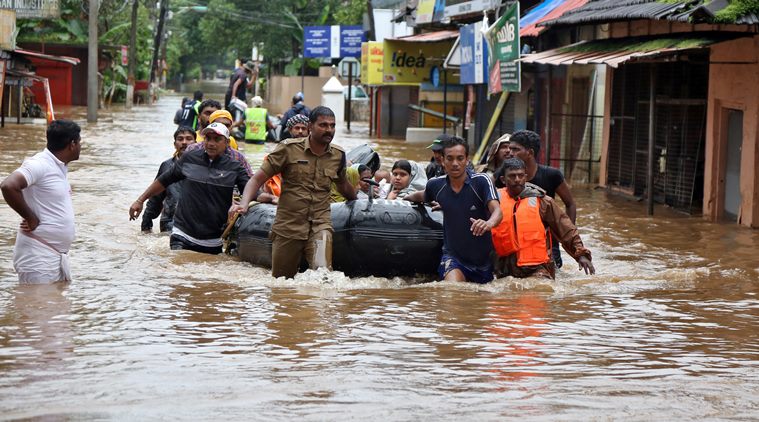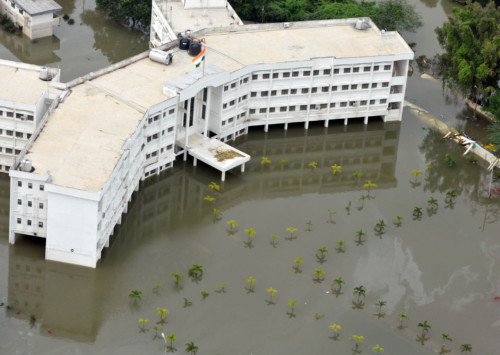Kerala floods: part of a larger cause
Contributing the largest amount of foreign remittance to India annually, Kerala (south India) today is ravaged by the century’s worst floods that have killed hundreds, injured thousands and rendered millions homeless. While heavy rains might have started the disaster, deforestation, illegal mining activities and more, have worsened the situation.
Affected by the worst floods in a century, over 400 people have lost their lives, about 2,00,000 families have taken refuge in relief camps and many others are missing in the state of Kerala (south India). More than 9,00,000 hectares worth of crops have been destroyed in the state. According to a preliminary assessment, total loss to the state and its people stands at USD 2.9 billion.
Though the state is receiving help from the Indian Army, Navy, Air Force, Coast Guard and National Disaster Response Force, fishermen as well as other countries like the UAE and Qatar, the government has an enormous task ahead of preventing water-borne diseases and monitoring relief work.
Even though heavy rains might have started this disaster, many other factors led to the worsening of situation. The rain was a result of confluence of the southwest monsoon wind system and the two low-pressure systems that formed over the Bay of Bengal and Odisha.
What wreaked havoc in the downstream areas was the state government’s decision to open 35 of its 39 dams. This led to not just landslides but also water engulfing important roads, forcing people to flee and leaving others hapless and stranded.
The loss of forest cover coupled with massive urbanisation is another factor that is said to have affected the rainfall pattern. According to a study by the Indian Institute of Science (IISc), Bengaluru, between 1973 and 2016, Kerala lost 9,06,440 hectares (9064.4 sq.km) of forest land. Extensive quarrying was cited as one of the major reasons for the recent calamity, which resulted in huge landslides. Consequently, several illegal constructions have sprouted on the river bed, violating laws and exploiting nature.
Most of the flood-affected areas have been classified as ecologically-sensitive zones (ESZs) by the Western Ghats Ecology Expert Panel (WGEEP). The report had recommended that the entire Western Ghats, spread over six states, including Kerala, be declared ecologically sensitive — and had assigned three levels of ecological sensitivity to regions within the ghats.
What happened in Kerala was not just a weather event but a part of the global climatic change. Several studies have pointed out that developing and poor economies will bear the brunt of climate change effects. Of this, South Asia is likely to be the worst-hit region globally.
While rains are likely to subside for five to seven days, Kerala is likely to get another heavy spell in September, before the monsoon retreats. But is the state prepared for it?
Earlier this year, disaster experts pointed out that India’s forecast dissemination system needs major changes. Sometimes radars are not maintained properly, and satellite images and weather information are not readily available to the public.
India Meteorological Department (IMD) is thus planning to expand its Doppler radar network that work by sending out electromagnetic waves that bounce back from moving objects in the air such as rain clouds. Analysing the way they bounce back, forecasters determine how heavy the rain is, where it is going, etc., and can aid forecast disasters two-three hours prior to severe weather events.
What India can learn from other nations
India’s size and geographical diversity makes it one of the most disaster-prone countries in Asia. Large coastal areas suffer from cyclones, mountains experience landslides and floods, and droughts regularly affect the central region. Every year, these result in huge loss of lives, damage infrastructure, and disrupt services.
India’s National Disaster Management Agency (NDMA) is thus working to develop a national disaster database by 2020. The database will include detailed statistics on every natural disaster in the country, including mortality rates, economic losses and interruption to services, to better understand the impact of disasters on the country’s development.
Two countries in Asia have already reflected benefits of such disaster databases. According to the data collected in Cambodia, highest death rates were because of floods, followed by lightning strikes. But the government had not paid attention to the latter.
In Indonesia, national agency for disaster management was muddled if it should distribute funds equally among regions or based on population density, or some other criteria. The country’s national disaster database provided a better answer – after looking at the disaster data, the agency categorised provinces in low, medium or high-risk locations. High-risk provinces consequently received more funds.
To ensure this level of adoption in India, the United Nations Development Programme (UNDP) is focusing on building capacities and providing technical know-how needed within the government. In May, Rajesh Sharma, a disaster risk information and application specialist at the UNDP conducted a workshop with Indian government representatives sharing experiences from other countries.
Indonesia for example, is developing additional applications that build upon the national disaster database. One example is the InaRisk application that is available to citizens, and uses historical disaster data to assess future disaster risks in different parts of the country.
India too, needs to build strong community communication systems, including FM radio with options for listeners to provide feedback that could be the start of a mechanism to share forecasts. For instance, in the US, the NOAA Weather Radio (NWR) serves as the ‘Voice of the National Weather Service’, a network of radio stations broadcasting continuous weather information.














